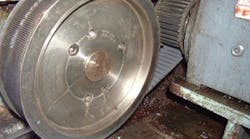Maintenance is serious business at Georgia-Pacific, where the underlying tenet of the company's World-Class Maintenance Continuous Improvement Program is "fix it before it fails."
For Doug Smith, maintenance manager of Georgia-Pacific's packaging division facility in Bradford, Pa., "continuous improvement" and "fix it before it fails" merged into a search for improved reliability of the cut-off knife machine.
Every year, the Bradford plant produces 90,000 tons of corrugated packaging. The head drive conveys sheets of corrugated paper through the plant's cut-off knife machine. During automatic order-change, the pull-rolls and sandwich belts of the upper and lower knives quickly speed up to discharge the tail of the previous order.
"The chain and sprocket drive on the head system was the weak point of the process," says Smith. "Georgia-Pacific's preventive maintenance/continuous improvement schedule is set at every two weeks." As a result, Smith says they were replacing the roller chain drive once a month because of excessive wear from the drive's high-speed and high-torque operation.
Gates PolyChain GT2 belt and sprocket system has reduced maintenance efforts at Georgia-Pacific's Bradford, Pa., facility.
Smith tackled the problem by installing hardened sprockets, but he says the chain was always stretching, showing signs of extreme wear and needing frequent replacement. He called Gates Power Transmission Product Applications and Motion Industries for help. In less than a week, the Bradford plant had a new Gates PolyChain GT2 belt and sprocket system on the head drive.
The PolyChain GT2 synchronous belt features a polyurethane body, aramid fiber tensile cord reinforcement and nylon tooth facing. These features allow it to transmit positive power over a range of loads while withstanding power surges and shock loads.
The Gates belt drive is maintenance-free and much quieter than the former chain system, according to Smith. "Now, there is no high maintenance in this area, and we remove the cover only during regular inspections," he says. Another big plus is that they no longer need to apply lubrication. Smith says they have eliminated the constant oil mess on the machine and surrounding area. This has eliminated unexpected down time and allows Georgia-Pacific to ship products on time.
And it also delivers on Georgia-Pacific's commitment to continuous improvement and world-class maintenance.
